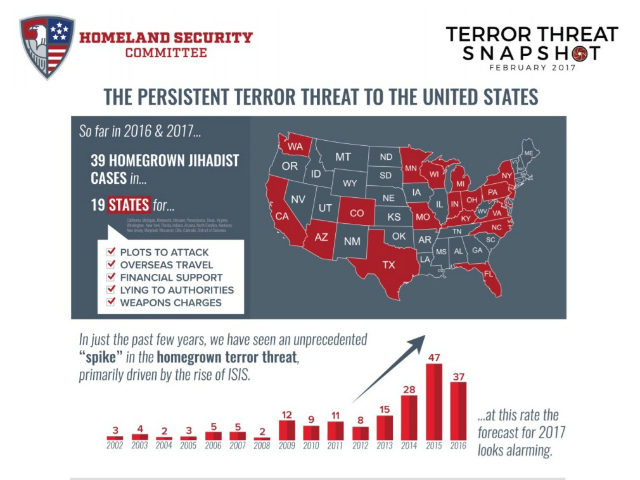The 2017 terrorism forecast for the United States and the rate at which Americans are being radicalized at home is “alarming,” according to a monthly assessment by the House Homeland Security Committee.
Citing an “unprecedented spike in the homegrown terror threat, primarily driven by the rise of” the Islamic State (ISIS/ISIL), the House panel’s Terror Threat Snapshot for February warns that, “at this rate, the forecast for 2017 looks alarming.”
“Authorities continue to track a high number of homegrown terror plots in the United States, and the number of cases since 9/11 is nearing a historic milestone: There have been nearly 200 total homegrown jihadist cases in the United States since 9/11 (the figure currently stands at 193), a majority having taken place in just the past few years,” points out the House report.
The monthly assessment attributes the alarming rise in the terror threat to the pressure ISIS is facing “in its key safe havens,” noting that the jihadist organization’s “external operations plotting appears undiminished.”
According to the report, there have been at least 39 homegrown jihadist plots or attacks across 19 U.S. states since the beginning of 2016.
In July 2016, FBI Director James Comey predicted that, as ISIS came close to defeat in its home turf of Iraq and Syria, the number of terrorist attacks against the U.S. and other Western countries would increase.
Echoing Comey, Michael McCaul (R-TX), chairman of the House Homeland Security Committee, said in a statement:
I am very encouraged that the Trump Administration is preparing to put greater pressure on jihadists in their safe havens throughout the world. But as they do, we can expect to see militants returning to the West to build new networks and to plot more deadly operations. I look forward to working with the new Administration on shutting down terror pathways in America. We must also remain vigilant here at home, because Americans are being radicalized at an alarming rate.
The Terror Threat Snapshot notes that the jihadist threat against Europe has also increased dramatically.
“European nations are moving forward with counterterrorism reforms designed to cope with the surging terror threat,” points out the assessment. “Yet despite improvements, the continent still suffers from major security weaknesses that make European countries more vulnerable to attack and put U.S. interests overseas at risk.”
Since 2014, there have been at least 166 ISIS-linked plots or attacks against Western targets, including 69 in Europe, 36 in the U.S., and 61 targeting Westerners outside those two regions.
The U.S.-led war against ISIS began in 2014, soon after the group announced the establishment of its now shrinking caliphate.
In the assessment, the House panel also notes that al-Qaeda and its ally the Taliban remain dangerous after more than 15 years of U.S.-led war against the terrorist groups.
“The Taliban threat has proven resilient and powerful in Afghanistan. According to an Afghan Defense Ministry official, the group is responsible for nearly 19,000 attacks throughout the country in just the past 10 months,” states the assessment. “Throughout that time, however, Afghan National Security Forces only carried out approximately 700 counter-insurgency operations.”
U.S. Gen. John Nicholson, the top commander of American and NATO forces in Afghanistan, told the Senate Armed Services Committee on Thursday that a few thousand more U.S. troops would help break the current “stalemate” with the Taliban.
“We remain very focused on the defeat of al-Qaeda and its associates, as well as the defeat of Islamic State Khorasan Province, which is the ISIL affiliate in Afghanistan,” he added. The U.S. declared war against al-Qaeda and the Taliban in Afghanistan in October 2001.

COMMENTS
Please let us know if you're having issues with commenting.